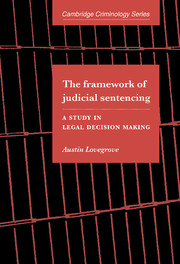Book contents
- Frontmatter
- Contents
- List of figures
- List of tables
- Acknowledgments
- 1 Judicial decision making and sentencing policy: continuation of a study
- 2 A sentencing decision model: single and multiple similar counts
- 3 A sentencing decision model: multiple disparate counts
- 4 Testing the decision model for multiple disparate counts
- 5 The techniques of data collection
- 6 Judges' thoughts on sentencing the multiple offender
- 7 An alternative sentencing decision model for the multiple offender
- 8 Validity and development of the alternative decision model: the data collection
- 9 Towards a requisite decision model for sentencing the multiple offender
- 10 The armature of judicial sentencing
- Appendix 1 Case 37 from Sentencing Research Exercise – Part 3B
- References
- Index
7 - An alternative sentencing decision model for the multiple offender
Published online by Cambridge University Press: 22 August 2009
- Frontmatter
- Contents
- List of figures
- List of tables
- Acknowledgments
- 1 Judicial decision making and sentencing policy: continuation of a study
- 2 A sentencing decision model: single and multiple similar counts
- 3 A sentencing decision model: multiple disparate counts
- 4 Testing the decision model for multiple disparate counts
- 5 The techniques of data collection
- 6 Judges' thoughts on sentencing the multiple offender
- 7 An alternative sentencing decision model for the multiple offender
- 8 Validity and development of the alternative decision model: the data collection
- 9 Towards a requisite decision model for sentencing the multiple offender
- 10 The armature of judicial sentencing
- Appendix 1 Case 37 from Sentencing Research Exercise – Part 3B
- References
- Index
Summary
The sentencing problems were developed and then administered to a sample of judges as a means of testing the hypothesized decision model describing how judges determine effective sentences for multiple offenders whose counts are separate transactions and offence categories and once appropriate sentences have been fixed for the multiple counts. A detailed analysis of the results is presented in the previous chapter: there the data are interpreted in terms of fourteen propositions, which cover those aspects of the decision model represented in the sentencing problems. One of the purposes of this chapter is to set out in general terms the fate of the model at the hands of the analysis; the second is to present information and discuss matters relating to the administration of the problems; the third is to state in a rounded-out and systematic form the principles of the alternative decision model discerned in the judges' responses and, then, to comment on its validity and limitations; and the fourth and final purpose of this chapter is to assess the extent to which this aspect of judicial sentencing is deliberative and to interpret the nature of judicial intuition, this being done in the light of the qualitative data from the sentencing problems, the latter with the aid of relevant theory.
Hypothesized decision model
Regarding the hypothesized decision model: first, the propositions for which there was substantial support are listed; secondly, the propositions which were rejected or for which the judges' position was equivocal are listed.
- Type
- Chapter
- Information
- The Framework of Judicial SentencingA Study in Legal Decision Making, pp. 150 - 168Publisher: Cambridge University PressPrint publication year: 1997



